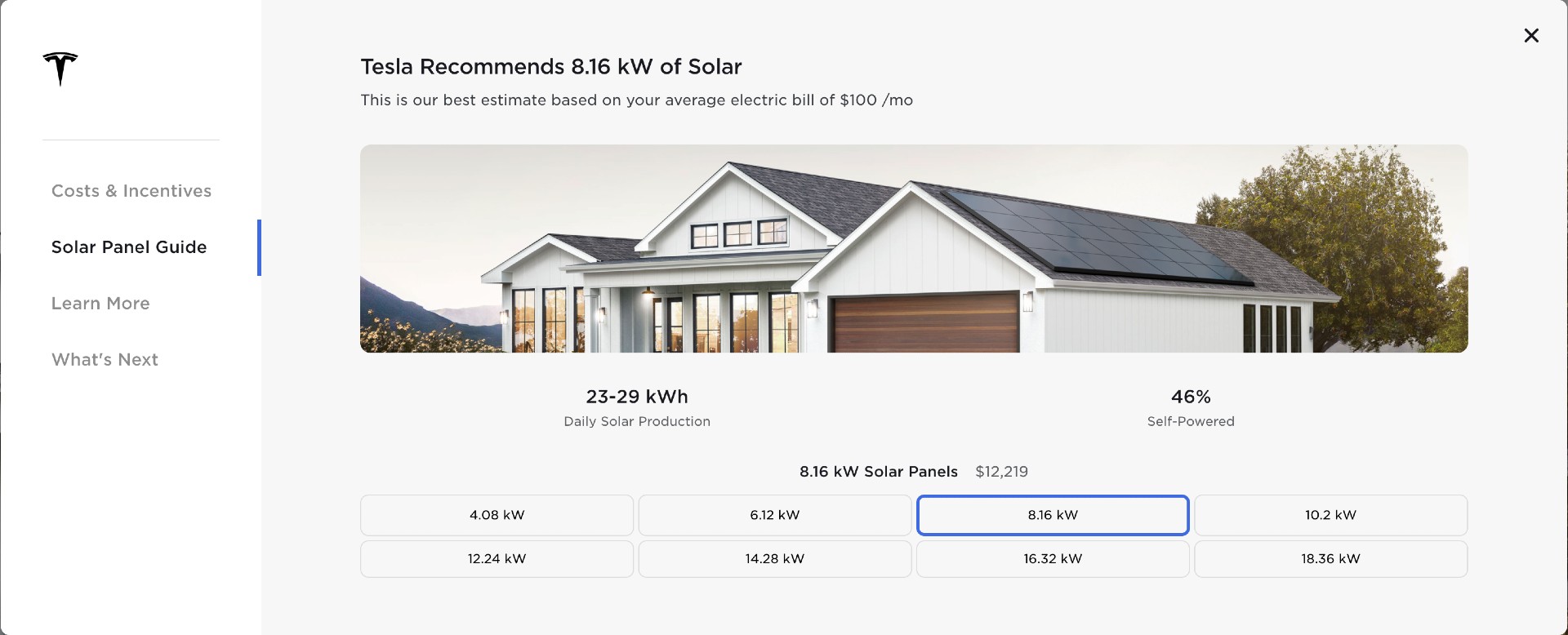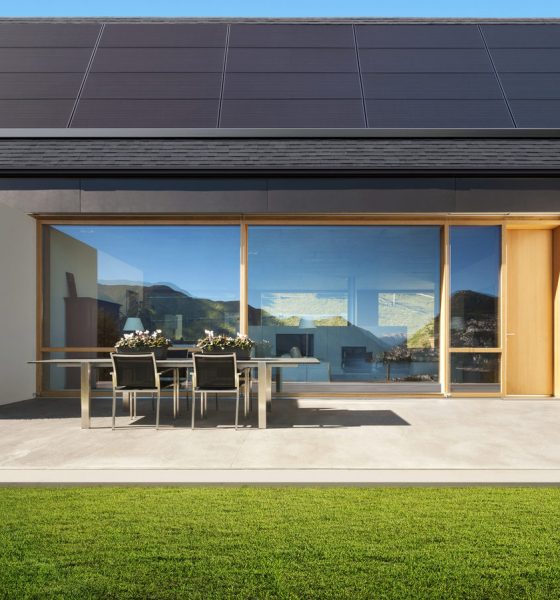Tesla has rolled out new solar panel options by providing four new sizes and new pricing points.
Tesla has made several modifications to its solar panel program in 2020, with the most recent appearing in mid-June. The sustainable energy company rolled out a new program over the summer that included new, higher-powered solar panel systems at more affordable pricing.
Now, Tesla has made further revisions to the program, adding four new sizing options that are more versatile and allow for a more customized fit to any sized home.
Credit: Tesla
In June, Tesla offered four new sizes for its solar systems that had more efficiency and lower pricing.
- Small – 4.08 kW – $10,000, $7,400 after incentives
- Produces 11-15 kWh daily
- Medium – 8.16 kW – $16,000, $11,840 after incentives
- Produces 23-29 kWh daily
- Large – 12.24 kW – $23,500, $17,390 after incentives
- Produces 33.44 kWh daily
- X-Large – 16.32 kW – $30,000, $22,200 after incentives
- Produces 45-58 kWh daily
Tesla has added four new systems that are not labeled with typical “sizing” descriptions. Now, they are labeled with their power capacity in kW. The pricing options listed below apply to California customers and vary in other states. New sizes are indicated with bold lettering.
- 4.08 kW – $8,200, $6,396 after incentives
- Produces 16-21 kWh daily
- 6.12 kW – $12,300, $9,594 after incentives
- Produces 23-31 kWh daily
- 8.16 kW – $16,400, $12,792 after incentives
- Produces 31-42 kWh daily
- 10.2 kW – $20,500, $15,990 after incentives
- Produces 39-52 kWh daily
- 12.24 kW – $24,600, $19,188 after incentives
- Produces 27-63 kWh daily
- 14.28 kW – $28,800, $22,386 after incentives
- Produces 55-73 kWh daily
- 16.32 kW – $32,800, $25,584 after incentives
- Produces 63-84 kWh daily
- 18.36 kW – $36,900, $28,782 after incentives
- Produces 70-94 kWh daily
The new, more well-rounded options provide a fit that will cater to more households. The previous options were sufficient enough, but as Tesla’s solar deployment continues to grow, the company may have needed to adapt by providing more sizing options moving forward.
Tesla’s Q3 Earnings Update letter detailed the company’s skyrocketing demand for solar panels. Energy storage deployments reach a record 759 MWh in Q3, and Powerwall demand is continuing to grow. With Solar Panels, Tesla cited that its low-cost systems are “starting to have an impact.” Total solar deployments continued to grow and more than doubled in Q3 thanks to Tesla’s Solar Roof and Solar Panels.
The main reason for Tesla’s continuing demand growth in its solar energy deployments comes down to pricing. Tesla Solar is 30% less expensive than the U.S. average, thanks to its focus on reducing soft costs. This included eliminating wages for sales representatives and allowing customers to buy their own solar packages online. Additionally, soft costs, which are non-component costs of the system, can attribute to higher pricing when systems are being ordered. Instead of having permits, inspections, and salespeople to pay, Tesla did away with these and slashed costs significantly.
Now that more sizing options are available, customers can get a solar panel outfitting from Tesla that is catered to the size of their home instead of buying a system that is more than big enough. This will reduce the possibility of a homeowner having to buy a system that is too big for their home and will save the customer money.
Of course, Tesla Solar can also be loaned for as little as $47 a month, and customers can also use the Subscription option, which runs as low as $65 a month.

Cybertruck
Tesla updates Cybertruck owners about key Powershare feature

Tesla is updating Cybertruck owners on its timeline of a massive feature that has yet to ship: Powershare with Powerwall.
Powershare is a bidirectional charging feature exclusive to Cybertruck, which allows the vehicle’s battery to act as a portable power source for homes, appliances, tools, other EVs, and more. It was announced in late 2023 as part of Tesla’s push into vehicle-to-everything energy sharing, and acting as a giant portable charger is the main advantage, as it can provide backup power during outages.
Cybertruck’s Powershare system supports both vehicle-to-load (V2L) and vehicle-to-home (V2H), making it flexible and well-rounded for a variety of applications.
However, even though the feature was promised with Cybertruck, it has yet to be shipped to vehicles. Tesla communicated with owners through email recently regarding Powershare with Powerwall, which essentially has the pickup act as an extended battery.
Powerwall discharge would be prioritized before tapping into the truck’s larger pack.
However, Tesla is still working on getting the feature out to owners, an email said:
“We’re writing to let you know that the Powershare with Powerwall feature is still in development and is now scheduled for release in mid-2026.
This new release date gives us additional time to design and test this feature, ensuring its ability to communicate and optimize energy sharing between your vehicle and many configurations and generations of Powerwall. We are also using this time to develop additional Powershare features that will help us continue to accelerate the world’s transition to sustainable energy.”
Owners have expressed some real disappointment in Tesla’s continuous delays in releasing the feature, as it was expected to be released by late 2024, but now has been pushed back several times to mid-2026, according to the email.
Foundation Series Cybertruck buyers paid extra, expecting the feature to be rolled out with their vehicle upon pickup.
Cybertruck’s Lead Engineer, Wes Morrill, even commented on the holdup:
As a Cybertruck owner who also has Powerwall, I empathize with the disappointed comments.
To their credit, the team has delivered powershare functionality to Cybertruck customers who otherwise have no backup with development of the powershare gateway. As well as those with solar…
— Wes (@wmorrill3) December 12, 2025
He said that “it turned out to be much harder than anticipated to make powershare work seamlessly with existing Powerwalls through existing wall connectors. Two grid-forming devices need to negotiate who will form and who will follow, depending on the state of charge of each, and they need to do this without a network and through multiple generations of hardware, and test and validate this process through rigorous certifications to ensure grid safety.”
It’s nice to see the transparency, but it is justified for some Cybertruck owners to feel like they’ve been bait-and-switched.
Energy
Tesla starts hiring efforts for Texas Megafactory
Tesla’s Brookshire site is expected to produce 10,000 Megapacks annually, equal to 40 gigawatt hours of energy storage.

Tesla has officially begun hiring for its new $200 million Megafactory in Brookshire, Texas, a manufacturing hub expected to employ 1,500 people by 2028. The facility, which will build Tesla’s grid-scale Megapack batteries, is part of the company’s growing energy storage footprint.
Tesla’s hiring efforts for the Texas Megafactory are hinted at by the job openings currently active on the company’s Careers website.
Tesla’s Texas Megafactory
Tesla’s Brookshire site is expected to produce 10,000 Megapacks annually, equal to 40 gigawatt hours of energy storage, similar to the Lathrop Megafactory in California. Tesla’s Careers website currently lists over 30 job openings for the site, from engineers, welders, and project managers. Each of the openings is listed for Brookshire, Texas.
The company has leased two buildings in Empire West Business Park, with over $194 million in combined property and equipment investment. Tesla’s agreement with Waller County includes a 60% property tax abatement, contingent on meeting employment benchmarks: 375 jobs by 2026, 750 by 2027, and 1,500 by 2028, as noted in a report from the Houston Business Journal. Tesla is required to employ at least 1,500 workers in the facility through the rest of the 10-year abatement period.
Tesla’s clean energy boom
City officials have stated that Tesla’s arrival marks a turning point for the Texas city, as it highlights a shift from logistics to advanced clean energy manufacturing. Ramiro Bautista from Brookshire’s economic development office, highlighted this in a comment to the Journal.
“(Tesla) has great-paying jobs. Not just that, but the advanced manufacturing (and) clean energy is coming to the area,” he said. “So it’s not just your normal logistics manufacturing. This is advanced manufacturing coming to this area, and this brings a different type of job and investment into the local economy.”
Energy
Tesla and Samsung SDI in talks over new US battery storage deal: report
The update was related by industry sources and initially reported by South Korean news outlets.

Recent reports have suggested that Tesla and Samsung SDI are in talks over a potential partnership to supply batteries for large-scale energy storage systems (ESS).
The update was related by industry sources and initially reported by South Korean news outlets.
ESS batteries to be built at Samsung’s Indiana plant
As noted in a report from Korea JoongAng Daily, the demand for energy storage systems has been growing rapidly in North America, thanks in no small part to the surge in AI investments across numerous companies. With this in mind, Tesla has reportedly approached Samsung SDI about a potential battery supply deal.
The deal is reportedly worth over 3 trillion Korean won (approximately $2.11 billion) and will span three years, according to The Korea Global Economic Daily. A battery supply deal with Samsung SDI could make sense for Tesla as the company already has a grid-scale battery, the Megapack, which is perfect for industrial use. Samsung SDI could simply supply cells for the EV maker.
Production of the batteries would reportedly take place at Samsung SDI’s joint venture factory with Stellantis in Indiana, which is currently under construction. Samsung SDI recently announced plans to use part of that plant’s EV lines to produce cells for ESS, with a targeted capacity of 30 GWh by the end of next year.
Tesla and Samsung’s partnership
At present, only a handful of manufacturers, including Korea’s LG Energy Solution, Samsung SDI, SK On, and Japan’s Panasonic, are capable of producing energy storage-scale batteries domestically in the United States. A Samsung SDI official issued a comment about the matter, stating, “Nothing has been finalized regarding cooperation with Tesla.”
The possible energy storage system deal adds another layer to Tesla’s growing collaboration with Samsung, which is already in line as a partner in the upcoming production of Tesla’s AI5 and AI6 chips. Early sample manufacturing of the AI6 is expected to begin in South Korea, with mass production slated for Samsung’s Texas-based Taylor foundry when it starts operations.
The AI6 chip will power Tesla’s next wave of high-volume projects, including the Optimus humanoid robot and the autonomous Cybercab service. Musk has called the partnership with Samsung a “real collaboration,” adding that he personally plans to “walk the line” at the Taylor facility to speed up progress.










